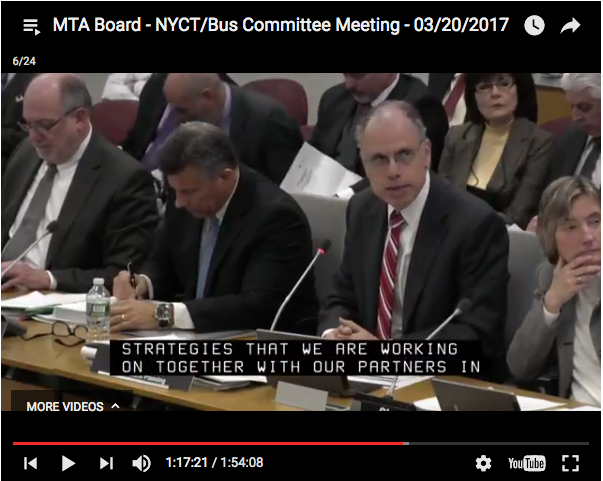
Last week New York City Transit acknowledged that agency-wide change is needed to improve bus performance, but what does that look like in practice? We’ll be provided some insight when the MTA finally reveals its Staten Island Comprehensive bus study.

“Given the dramatic changes in ridership and continuing pressures in operations, we cannot sit still and hope things will change on their own.” Peter Cafiero addressing steady bus ridership decline, 3/20/2017 NYCT & Bus Committee Meeting.
As we have noted, the changes that have resulted from recent MTA bus studies have been minimal. The Staten Island study is an opportunity for the MTA to take a more ambitious approach and make the changes needed to bring riders faster and more reliable bus trips. They have the full support of Borough President James Oddo, who has called for big changes, asking his fellow Staten Islanders to join him in “hoping the MTA thinks out of the box and goes a bit rad.”
So, where is the study? The initial report was expected last summer, but it’s nearly April and Staten Island’s bus riders are still waiting.
Unlike Manhattan, Brooklyn, and the Bronx, Staten Island doesn’t have dwindling ridership, but that doesn’t mean its buses are working as well as they should. Staten Island residents endure some of the longest average commute times in the country and are plagued by some of the same reliability issues that characterize bus service throughout NYC. Furthermore, despite population growth and changing travel patterns, Staten Island’s bus routes haven’t seen serious alterations in decades.

The MTA’s initial recommendations are expected to be focused on express buses, but local routes are in need of change too. Our recent analysis showed that riders on the S48 travel at an average speed of just 8.2 mph during daytime hours, while the bus reaches average speeds of 12.5mph at night. Our Bus Turnaround Coalition has recommended street priority treatments along the S48 route, such as bus lanes in trouble spots, where riders have a lot to gain.

Last March, we co-hosted a hackathon with MTA-New York City Transit and NYU’s Rudin Center for Transportation at which civic technologists from competed to develop the best proposals for network design changes to improve the travel times and reliability of Staten Island routes. The key recommendation of the winning entry was that the number of express bus stops in Manhattan should be reduced. This was based on analysis showing that most riders disembark at a small set of key stops in Manhattan, while buses spend a good deal of time stuck in Manhattan traffic. We expect bold network redesign and stop-spacing adjustments within Staten Island will also be among proposed changes.
 On the Brink: Will WMATA’s Progress Be Erased by 2024?
On the Brink: Will WMATA’s Progress Be Erased by 2024?
The experience of being a WMATA rider has substantially improved over the last 18 months, thanks to changes the agency has made like adding off-peak service and simplifying fares. Things are about to get even better with the launch of all-door boarding later this fall, overnight bus service on some lines starting in December, and an ambitious plan to redesign the Metrobus network. But all of this could go away by July 1, 2024.
Read More Built to Win: Riders Alliance Campaign Secures Funding for More Frequent Subway Service
Built to Win: Riders Alliance Campaign Secures Funding for More Frequent Subway Service
Thanks to Riders' Alliance successful #6MinuteService campaign, New York City subway riders will enjoy more frequent service on nights and weekends, starting this summer. In this post, we chronicle the group's winning strategies and tactics.
Read More